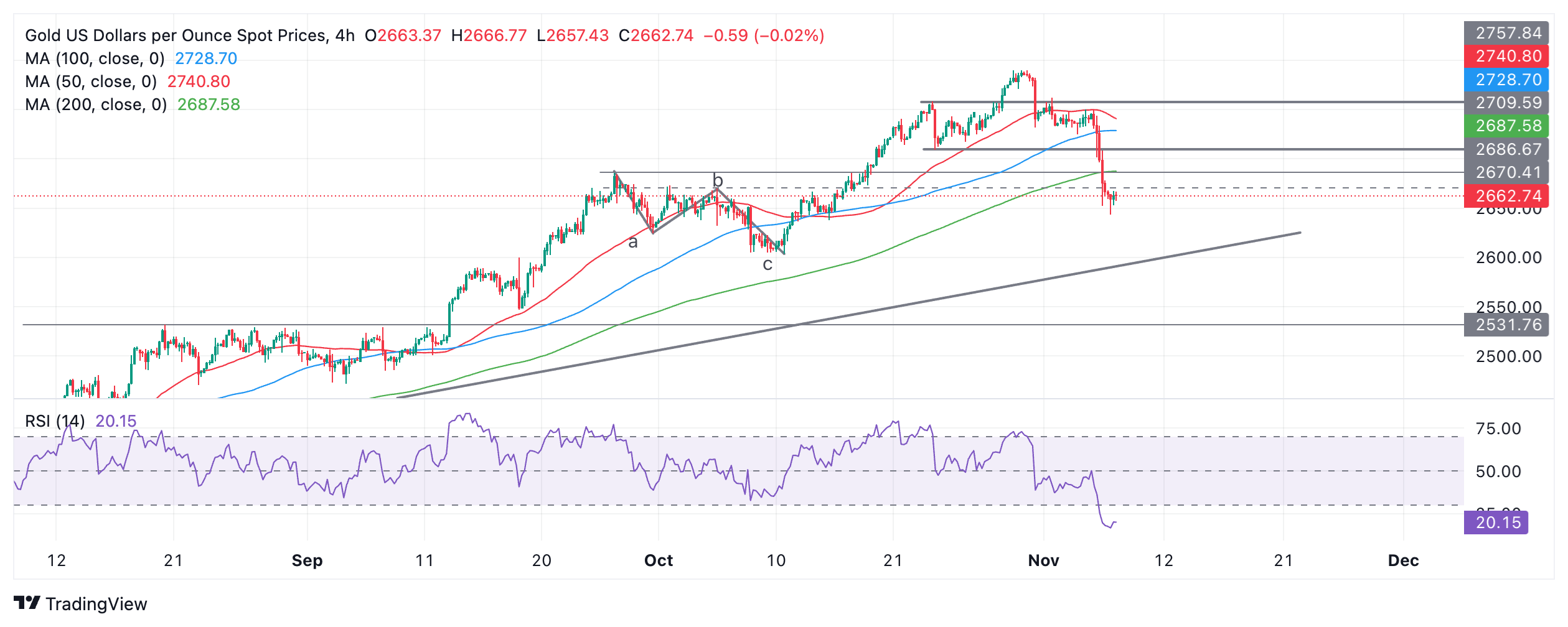- Gold finds its feet on Thursday after experiencing a 3.0% fall following the news of Donald Trump’s victory in the presidential race.
- A stronger US Dollar, capital pivoting into riskier assets, and potential unwinding of geopolitical risks were all bearish drivers.
- Technically, XAU/USD extends its short-term downtrend although the RSI momentum indicator is oversold.
Gold (XAU/USD) bounces back into the $2,670s on Thursday after falling three percent on the previous day when now President-elect Donald Trump secured a victory in the US presidential election.
Gold falls 3.0% as Donald Trump wins election
Gold's steep decline on Wednesday was partly a result of the US Dollar (USD) strengthening due to Trump’s Dollar-positive economic agenda and preference for pro-tariff protectionism. Since Gold is mainly priced and traded in USD, the stronger Dollar had an immediate negative impact on its price.
Trump won the presidency by passing the 270 electoral votes threshold. On Thursday, Trump has 295 votes to Harris’ 226, according to the Associated Press. The Republican party also has a majority in the United States (US) Senate – 52 over 44 – and is in the lead to win a majority in the US Congress, with 206 seats versus the Democrat’s 191 so far, although 38 have still to be called.
The precious metal may have been further hit by investors’ preference for alternative, riskier assets, such as Bitcoin (BTC), which hit a new all-time high due to expectations that Trump would relax crypto regulation. Stocks also rose to record heights due to anticipated tax cuts and a looser regulatory environment overall. These all came at the cost of Gold, which saw outflows as investors rebalanced portfolios.
Gold also rises during geopolitical crises and wars from increased safe-haven demand. Trump’s claims that he can end the conflicts in the Middle East and Ukraine, though seemingly exaggerated (“I will have that (Ukraine-Russia) war settled in one day – 24hrs,” Trump said once), however, probably also hit safe-haven flows.
Technical Analysis: XAU/USD enters short-term downtrend
Gold shatters the glass of $2,700 and falls to the mid $2,650s on Thursday. The precious metal is now in a short-term downtrend and, given the principle that “the trend is your friend,” it is vulnerable to further weakness in the near term.
XAU/USD 4-hour Chart
That said, the Relative Strength Index (RSI) momentum indicator has entered deep into oversold territory, indicating short-holders should not add to their positions. If the RSI exits oversold, sellers are advised to close their trades and open tentative longs, as it will be a signal that the price will probably correct higher.
Due to the bearish short-term trend, a break below the $2,643 daily low would confirm a continuation, probably to the next downside target at $2,605, the trendline for the long-term trend.
The precious metal remains in an uptrend on a medium and long-term basis, with a material risk of a reversal higher in line with these broader up cycles. At the moment, however, there are no technical signs of this happening.
A break above the all-time high of $2,790 would re-confirm the medium-term uptrend and probably lead to a move up to resistance at $2,800 (whole number and psychological number), followed by $2,850.
US Dollar FAQs
The US Dollar (USD) is the official currency of the United States of America, and the ‘de facto’ currency of a significant number of other countries where it is found in circulation alongside local notes. It is the most heavily traded currency in the world, accounting for over 88% of all global foreign exchange turnover, or an average of $6.6 trillion in transactions per day, according to data from 2022. Following the second world war, the USD took over from the British Pound as the world’s reserve currency. For most of its history, the US Dollar was backed by Gold, until the Bretton Woods Agreement in 1971 when the Gold Standard went away.
The most important single factor impacting on the value of the US Dollar is monetary policy, which is shaped by the Federal Reserve (Fed). The Fed has two mandates: to achieve price stability (control inflation) and foster full employment. Its primary tool to achieve these two goals is by adjusting interest rates. When prices are rising too quickly and inflation is above the Fed’s 2% target, the Fed will raise rates, which helps the USD value. When inflation falls below 2% or the Unemployment Rate is too high, the Fed may lower interest rates, which weighs on the Greenback.
In extreme situations, the Federal Reserve can also print more Dollars and enact quantitative easing (QE). QE is the process by which the Fed substantially increases the flow of credit in a stuck financial system. It is a non-standard policy measure used when credit has dried up because banks will not lend to each other (out of the fear of counterparty default). It is a last resort when simply lowering interest rates is unlikely to achieve the necessary result. It was the Fed’s weapon of choice to combat the credit crunch that occurred during the Great Financial Crisis in 2008. It involves the Fed printing more Dollars and using them to buy US government bonds predominantly from financial institutions. QE usually leads to a weaker US Dollar.
Quantitative tightening (QT) is the reverse process whereby the Federal Reserve stops buying bonds from financial institutions and does not reinvest the principal from the bonds it holds maturing in new purchases. It is usually positive for the US Dollar.
Information on these pages contains forward-looking statements that involve risks and uncertainties. Markets and instruments profiled on this page are for informational purposes only and should not in any way come across as a recommendation to buy or sell in these assets. You should do your own thorough research before making any investment decisions. FXStreet does not in any way guarantee that this information is free from mistakes, errors, or material misstatements. It also does not guarantee that this information is of a timely nature. Investing in Open Markets involves a great deal of risk, including the loss of all or a portion of your investment, as well as emotional distress. All risks, losses and costs associated with investing, including total loss of principal, are your responsibility. The views and opinions expressed in this article are those of the authors and do not necessarily reflect the official policy or position of FXStreet nor its advertisers. The author will not be held responsible for information that is found at the end of links posted on this page.
If not otherwise explicitly mentioned in the body of the article, at the time of writing, the author has no position in any stock mentioned in this article and no business relationship with any company mentioned. The author has not received compensation for writing this article, other than from FXStreet.
FXStreet and the author do not provide personalized recommendations. The author makes no representations as to the accuracy, completeness, or suitability of this information. FXStreet and the author will not be liable for any errors, omissions or any losses, injuries or damages arising from this information and its display or use. Errors and omissions excepted.
The author and FXStreet are not registered investment advisors and nothing in this article is intended to be investment advice.
Recommended content
Editors’ Picks

EUR/USD struggles to find upside traction near 1.0950
EUR/USD remains below the 1.1000 barrier and trades with humble losses on the back of the acceptable rebound in the Greenback, as market participants continue to adjust to Trump's announcement of a 90-day pause on reciprocal tariffs on non-retaliating countries.

GBP/USD retakes 1.2800 and above
GBP/USD manages to keep the bullish bias despite the decent bounce in the US Dollar, navigating the area above 1.2800 the figure as investors continue to assess the ongoing US-China trade war. US doubles the bet, announced 125% levies on Chinese imports.

Gold remains bid, refocuses on $3,100
Prices of Gold now regain some balance and approach the $3,100 zone per troy ounce on Wednesday after President Trump announced a 90-day pause on reciprocal and 10% tariffs. FOMC Minutes pointed to further caution from officials.

Dow Jones Industrial Average rockets 6% higher on tariff suspension
The Dow Jones Industrial Average (DJIA) skyrocketed on Wednesday, surging over 6% on the day and returning to the 40,000 handle after the Trump administration announced yet another pivot on its own tariff policies.

Tariff rollercoaster continues as China slapped with 104% levies
The reaction in currencies has not been as predictable. The clear winners so far remain the safe-haven Japanese yen and Swiss franc, no surprises there, while the euro has also emerged as a quasi-safe-haven given its high liquid status.

The Best brokers to trade EUR/USD
SPONSORED Discover the top brokers for trading EUR/USD in 2025. Our list features brokers with competitive spreads, fast execution, and powerful platforms. Whether you're a beginner or an expert, find the right partner to navigate the dynamic Forex market.




